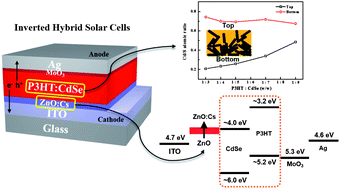Air-stable inverted structure of hybrid solar cells using a cesium-doped ZnO electron transport layer prepared by a sol–gel process
Abstract
We have developed an air-stable inverted structure of poly(3-hexylthiophene) (P3HT) :

* Corresponding authors
a
National Creative Research Center for Block Copolymer Self-Assembly, Department of Chemical Engineering and Polymer Research Institute, Pohang University of Science and Technology, Gyungbuk 790-784, Korea
E-mail:
twlee@postech.ac.kr, jkkim@postech.ac.kr
Fax: +82 279 8298
b Department of Materials Science and Engineering, Pohang University of Science and Technology, Gyungbuk 790-784, Korea
c Department of Chemical Engineering and Polymer Research Institute, Pohang University of Science and Technology, Gyungbuk 790-784, Korea
We have developed an air-stable inverted structure of poly(3-hexylthiophene) (P3HT) :

 Please wait while we load your content...
Something went wrong. Try again?
Please wait while we load your content...
Something went wrong. Try again?
S. Kwon, K. Lim, M. Shim, H. C. Moon, J. Park, G. Jeon, J. Shin, K. Cho, T. Lee and J. K. Kim, J. Mater. Chem. A, 2013, 1, 11802 DOI: 10.1039/C3TA12425H
To request permission to reproduce material from this article, please go to the Copyright Clearance Center request page.
If you are an author contributing to an RSC publication, you do not need to request permission provided correct acknowledgement is given.
If you are the author of this article, you do not need to request permission to reproduce figures and diagrams provided correct acknowledgement is given. If you want to reproduce the whole article in a third-party publication (excluding your thesis/dissertation for which permission is not required) please go to the Copyright Clearance Center request page.
Read more about how to correctly acknowledge RSC content.
 Fetching data from CrossRef.
Fetching data from CrossRef.
This may take some time to load.
Loading related content
